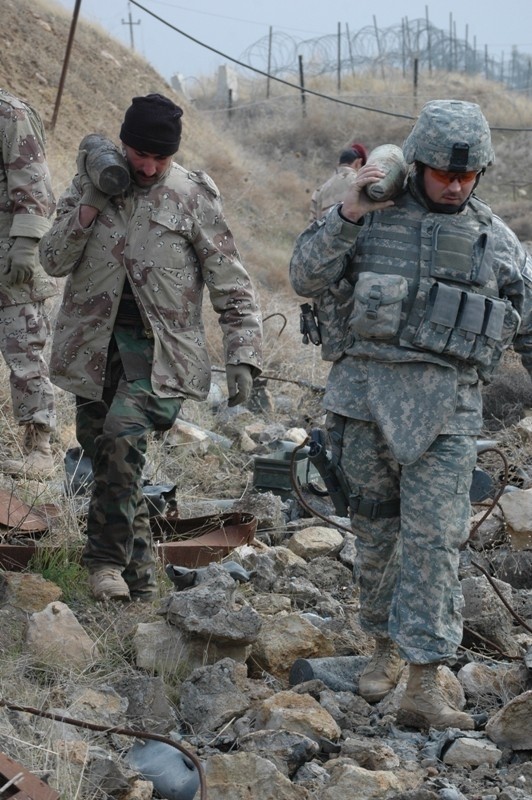FORWARD OPERATING BASE MAREZ, Iraq (Army News Service, Jan. 9, 2007) - Soldiers from the 18th Explosive Ordinance Disposal Company, based at Fort Bragg, N.C., assumed the role of mentor and observer to 15 troops from the 2nd Iraqi Army Division who then demonstrated their abilities by conducting an operation to destroy unexploded ordnance Jan. 7
"We are responsible for training and certifying all of the Iraqi EOD soldiers in both the 2nd IA and the 3rd IA," said Capt. Jim Hartman, commander of the 18th EOD Co. "This particular validation mission for the IA involves the removal of unexploded ordnance from an ammunition supply point that had suffered from an explosion and fire here some time ago."
The 2nd IA soldiers began by identifying the rounds that were scattered within the debris of the ASP. Once they were identified, they were loaded onto a trailer and taken to the actual demolition site on the far side of FOB Marez for reduction.
"These troops will be conducting this disposal completely on their own, from start to finish," said Hartman. "My guys will be observing and standing by only in case they have any questions or need any assistance. It is an Iraqi-run operation, through and through."
"The 2nd IA troops here today are all Level 3 certified," explained Capt. John Engroos, a member of the 2nd IA Military Transition Team living with the soldiers at their base in Al-Kindi. "During instruction in levels 1-3, the Iraqis are taught everything from basic explosive characteristics and capabilities, to the proper identification of rounds."
The training fully qualifies them, after validation, to execute unexploded ordnance reduction independently and to handle all matters pertaining to proper handling of explosives.
"Level 4 instruction is the final phase of training and is conducted at a school in Basra. It involves the procedures of traveling on-site and handling discovered IEDs in the field," added Engroos.
The 2nd IA currently has five troops attending level 4 training and several more scheduled for the next class. The end state, according to Hartman, is a fully-qualified team within the Iraqi Army who can independently operate and eliminate the IED threat posed to Iraqi Security Forces, Iraqi civilians, and coalition troops.
"The 15 IA soldiers we have here are all very well trained at executing the tasks - they're very professional," said 1st Sgt. Eugene Salet, 18th EOD Co. "They're highly motivated and well led by their lieutenant and eager to learn."
After the old mortar and artillery rounds were unloaded at the detonation site, the 2nd IA troops stacked them into two piles and placed C-4 charges on them to complete the reduction. Two stacks were necessary because of safety limitations regarding the size of controlled detonations according to Hartman.
Once rigged, the IA troops and coalition counterparts moved a safe distance to the other side of a hill and activated the explosives, eliminating the old munitions. An immediate post-blast analysis of the area was conducted to visually determine if everything had been reduced successfully.
"It was a great way to spend a Sunday afternoon; great weather, great training, and a safe and successful elimination of some explosives that won't find their way onto the streets in the form of IEDs," said Hartman.


Social Sharing